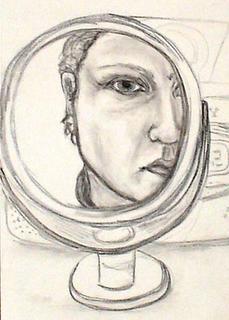Contour drawing - Drawing in which contour lines are used to represent subject matter. A contour drawing has a three- dimensional quality, indicating the thickness as well as height and width of the forms it describes. Making a contour drawing with a continuous line is a classic drawing exercise (sometimes modified as a "blind continuous-line contour"): with eyes fixed on the contours of the model or object, drawing the contour very slowly with a steady, continuous line, without lifting the drawing tool or looking at the paper.
from http://www.artlex.com/ (There are also some excellent examples of contour drawings with the definition!)
The basic idea of blind contour drawing is to not watch your hand as it draws but to have your hand mimic the movement of your eyes as they follow the edges of the object being drawn.
I don't really use blind contour drawings as an assignment to be marked but they are an excellent way to train your students' hands to draw what their eyes really see rather than what they think they see. You may still choose to mark all of the blind and regular contour drawings a student does as one assignment.
The blind contour drawings may not look like much more than a scribble at first but as you and/or your students continue to do them you will begin to see an actual likeness of the object begin to appear in your drawings.
Blind contour
- White crayons (you can use white pastels but they can be seen on the paper)
- White Paper
- Everyday Objects (shoes, plants, desks, pencils etc.)
- Pencils (If you can let students experiment with actual art pencils which have varied softness and hardness rather than the usual HB do so! I have found art pencils at dollar stores and while they aren't artist quality, they will give the students a chance to use the kinds of tools artists use.)
- Paper
- Everyday objects
What You Do:
- I like to go over the definitions of contour and blind contour drawing for students and show them some examples that I have done or that I have found before I ask students to attempt the work themselves.
- I always get students to do the blind contours first, so they will need only white crayons and paper to begin with. I then ask students to pick an object in the room and then pick a point on the object where the eye can begin its slow movement around the contour. You will have to remind students that the eye and hand need to move slowly!
- As your eye moves, so should your hand holding the pencil. Try to mimic the movement of your eyes on the object with your hand on the paper. Don't look at your drawing and try to draw without ever disconnecting your pencil from the paper.
- Do a color wash over the crayon so you can see the drawings. Names on papers are really important here!
- For the contour drawings, have students repeat the steps for blind contour as much as they can but this time they can use pencil and look at the drawing occasionally. NO ERASERS!
I've added the following pics of blind contours I did in high school as examples. (There are also a number of more recent contour and blind contour drawings on this blog.)
the first two drawings are different views of the same image, I had to play with the contrast and color saturation to make the image more visible. They were my attempts at drawing a blind contour of a friend's face with white crayon. Blind contour portraits can be a lot of fun but you really need to know your kids well and know that they all have a sense of humor!

 The last is a blind contour of my boot in charcoal on paper. Charcoal is messy but is wonderful to work with... a box of it is cheap but it will make a big mess so smocks and clean up time would be necessary!
The last is a blind contour of my boot in charcoal on paper. Charcoal is messy but is wonderful to work with... a box of it is cheap but it will make a big mess so smocks and clean up time would be necessary!




